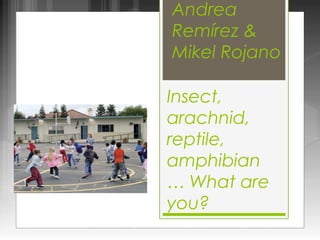
Insect
- 1. Andrea Remírez & Mikel Rojano Insect, arachnid, reptile, amphibian … What are you?
- 2. Statement of problem The janitor of the school came to the class and bring a letter to the teacher. She read in loud the following: “Dear Students: We are having problems with the huge amount of bugs that have appear in the playground these past weeks. We want to exterminate the area but we need a different product for each specie so we require your help. In your case you have to determinate
- 3. Brain Storming Session What could you find in the playground? List at least six insects
- 6. Essential question How many legs do insects have? What do they eat? How are they born? How many body parts do they have? Where do they usually live?
- 7. Answering They have 6 legs. Theydon’t have any special diet, they could eat from leaves to wood. Insects are born from eggs that their mothers lay. They have 3 body parts. Theydon’t have any special habitat, you could find them almost everywhere.
- 8. Put the knowledge in practice Once they have been working with the main characteristics of the insects they are going to identify them in the pictures. Theyhave to know which of the 8 different kinds of bugs that we have in the playground are insects. Theyare working in groups of 3 people so once all of them have the answer to the question they should contrast the varied information.
- 9. Put the knowledge in practice The answer to the letter of the janitor could be: “Dear janitor, we have become experts in insect and taking in to account their special features we can guarantee that the followings are insects: Ant Cockroach Bee Grasshopper Lepisma
- 10. Image credits SCHOOLYARD http://www.sbs.utexas.edu/fireant/ ANT http://www.factzoo.com/insects/cockroach.html COCKROAC englishirond.wikispaces.com/file/detail/schoolyard.jpg/337 H http:// www.pesticide.org/solutions/phase-2-solutions-for-consum SPIDERhttp:// http:// http:// www.casadeinsecticidas.com.ar/detalle_plaga.php?id BICHO BOLA
- 11. Image credits http://www.dangerouscreation.com/2012/08/make- / BEE http:// phoenix.about.com/od/arizonapicturesandphotos/i SCORPION http:// www.animalesprehistoricos.com/2011/12/lepismas-u LEPISMA http:// richardxthripp.deviantart.com/art/Yellow-Grasshopp